Innovation in China – Part I – Shaanxi Province and Xi’an
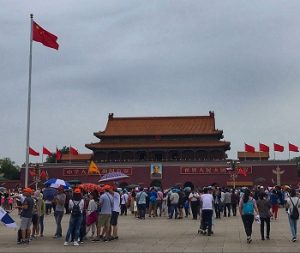
Imperial Palace, Beijing
The topic of innovation in China is receiving a great deal of attention lately. As China’s economy continues to grow at a brisk rate and its GDP appears headed to surpass that of the United States, many observers are wondering whether China is poised to become the leading superpower of the 21st century. Statistically, China is well-positioned to assume this title, with astounding annual GDP growth, an increasing focus on global engagement, and a huge population. Earlier this year, according to Elizabeth Economy, the Director for Asia Studies at the Council on Foreign Relations, a Chinese official referred to his country for the first time as a superpower (chaoji daguo).
Indeed, many people forget that China is merely on track to resume a position it has held in the past – that of the world’s most powerful nation. Between 1100 and 1800 AD, China was the most technologically-advanced civilization on the planet, with many of its cities serving as among the most densely-populated and sophisticated urban areas in the world. During this period, China led the world in production of steel, textiles, agriculture, trade, paper, printing, firearms, tools, navigation, and many other areas, lasting up until the start of the Industrial Revolution in the West. The question thus arises today as to whether China will resume its position on the top of the economic ladder or whether Western countries, especially the United States, can continue to maintain a leadership role.
Much of the focus on China today centers on its ability to innovate. While China’s Xinhua news agency recently proclaimed that China’s innovative capabilities are manifested in four areas: dock-less shared bikes, high-speed rail, online payments and e-commerce; one could argue that all of these technologies were invented elsewhere. While China may be a leader in the scale of the application of these four
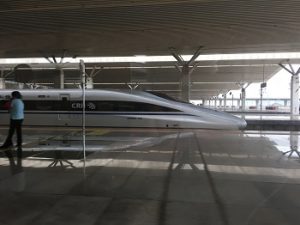
Chinese Bullet Train
technologies (in terms of numbers of users), China was nonetheless heavily dependent on foreign technology when these four areas were first implemented. I would add to this list a recent rather Orwellian innovation in China – the social credit score – in which the Chinese government gathers data to track of the behavior of its citizens and uses that information to determine if individual citizens are allowed to travel (internally or abroad) or engage in other social activities, such as using internet dating sites. China may also be the world leader in another dystopian technology – the use of surveillance cameras in public spaces combined with facial recognition software to monitor its population.
Some would argue that the closed nature of the Chinese society, with its “great firewall of China†blocking access to some foreign websites and tight control over its people, renders the overall country less able to innovate and more likely to find ways to take intellectual property (both legitimately and illegitimately) from elsewhere and apply it internally. In other words, studying Chinese innovation relative to the rest of the world means trying to decipher whether a society organized around the concept
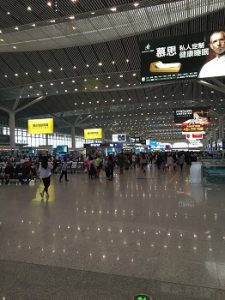
Asia’s Largest Railway Station – Xi’an Bei
of order and assimilation can compete from an innovation standpoint with societies organized around the principles of freedom, liberty, and diversity. One recent Wall Street Journal article noted that Chinese companies are recruiting heavily in America’s Silicon Valley, trying to lure US-based Chinese experts to return to China and pursue their technology dreams there, which suggests that indigenous innovation in China may not be adequate to sustain the country’s economic momentum, despite huge government investment in the development of new technologies, such as the Made in China 2025 program.
As we try to define what is truly innovative, one might ask whether the application of a new technology is as significant as the original invention of the new technology. An innovator can also ask whether marginal improvements to an original technology are worthy of the imprimatur of “innovation,†or whether that term should be reserved for truly novel creations. I recently traveled to China for the first time to investigate some of these claims and found an economy that was developing at a scale that was almost beyond comprehension. On high-speed train trips from Shanghai to Xi’an and subsequently from Xi’an to Beijing, one could see construction underway on towering residential buildings and corporate office parks in quantities that were almost too numerous to count, with more construction cranes in use that I thought even existed on the planet. While many of these sites were completely idle, raising the question of whether a property bubble is underway, the scale of construction is nonetheless impressive.
In China’s cities, where the scale of population and buildings dwarfs anything seen in the West, one can sense a vibrant and growing economy, filled with individuals plying their trades with a view towards a more prosperous future. China is taking steps to position its industries at the forefront of emerging technologies (such as artificial intelligence), and also seeking to expand its global influence and access to raw materials and energy via the Belt and Road Initiative. While I do not doubt that innovation is underway in modern China, I nonetheless found myself pulled towards

Endless Buildings in Central China
China’s past to find the roots of innovation in the Middle Kingdom. I was unable to render a verdict on the current state of innovation in China, but I can say that innovation permeates China’s history and the past is often a sound predictor of the future. In these examples from China’s past, the modern innovator can see threads, and apply lessons learned, to aid in the development of new innovations.
This is the first of a two-part series on innovation in China. Part I focuses on the archaeological wonderland of Shaanxi Province and its amazing capital city of Xi’an. Part II addresses the megalopolises of Shanghai and Beijing as well as the ancient water town of Tongli.
Xi’an
Some say that the shape of the country of China is similar to that of a rooster with the head in the northeast, the tail pointed west, and the feet in the south. At the spot
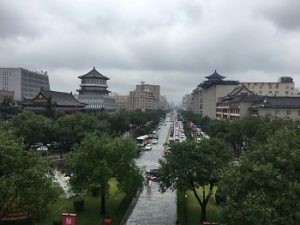
City of Xi’an
where the rooster’s heart would be located sits the ancient city of Xi’an, which was once the capital of China during many of its most important dynasties. Xi’an sits in the Guanzhong Plain in the province of Shaanxi and is the home of the world’s best- preserved ancient city walls. Xi’an is certainly best known for one of the most amazing archaeological finds of the 20th century – the tomb of Emperor Qin Shi Huang and his army of life-size terracotta warriors. Although home to over 12 million inhabitants, Xi’an augurs true to its ancient roots and does not feel like the megalopolises of Shanghai or Beijing. Xi’an is also famous as the starting point of the ancient trade route known as the Silk Road, which ran from China across central Asia towards southern Europe.
Drum and Bell Towers
A common sight in ancient Chinese cities are two large, ornate towers inside the city walls, known as the Bell Tower and the Drum Tower. Each tower had a different purpose and provided critical information for town residents. The Bell Tower
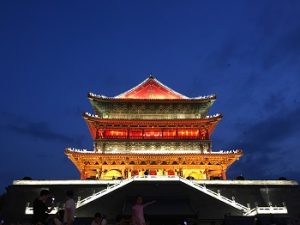
Xi’an Bell Tower
contained a bell that was rung to communicate the time of day so residents, in the era before personal timekeeping devices, would be able to coordinate their work and life activities. The bell could also be rung to indicate the imminent announcement of news. The Drum Tower, on the other hand, contained a huge drum that would be struck repeatedly at the end of the day towards sunset to signify when the city’s gates would be closed. A city’s gates needed to be closed on a nightly basis for security, and anyone caught outside the gates would have to fend for himself or herself until the next morning. The number of beats of the drum was quite high (as many as 200) to allow residents outside the city sufficient time to return to the city walls and re-enter the city before the gates closed.
Innovation Thoughts – A modern innovator can benefit from thinking about the two organizing principles that pervade the Bell and Drum Towers. The first principle is
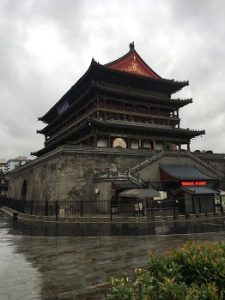
Xi’an Drum Tower
that of a regular cadence that allows everyone within a defined grouping (whether a city, company, division, or team) to coordinate work and other activities. An innovation leader should be aware of the communication techniques he or she uses to synchronize activities on the part of his or her team. The messages communicated need to be clear, concise, consistent, and far-reaching, so that everyone on the team is getting the same information at the same time. This reduces the likelihood of mistakes or duplicated work efforts by keeping everyone aware of the key activities underway in the organization. Like the Bell Tower, the information provided should be very concise so that people are not overwhelmed with too much content.
The second principle is that of a defined operating radius or boundary within which a team is working. The Drum Tower’s 200 beats represented a fixed amount of time and anyone working outside of the city gates needed to make sure that he or she would not be so far away that returning to the city would be impossible once the drumbeats began at the end of the day. For the innovator, the parallel here would be a sense of scope of exploration, whether in an ideation workshop or in other investigative work on an initiative, to make sure that one does not stray too far from the original goal of the work effort. Just as it was important for residents of a Chinese city to perform work outside the walls (such as farming, raising livestock, fishing, or other endeavors), so, too, is it important for an innovator and his or her team to expand their horizons beyond the base scope of an initiative and explore new ideas and approaches to solve a problem. Yet at some point these exploratory efforts can get too far afield, so the concept of some sort of boundary that can be established in advance, like a Drum Tower, would be useful to keep a team focused on the original objective.
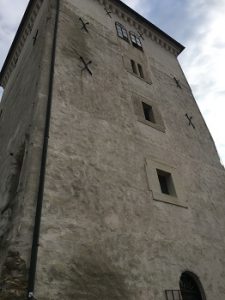
Zagreb Lotrscak Tower
Interestingly, the same two communication concepts appear in the Croatian city of Zagreb, though they are consolidated into a single edifice with slightly different notification techniques. The Lotrscak Tower, also known as the Tower of Thieves, contained a bell that would be rung to notify residents of the closing of the town gates. The “Tower of Thieves†name signified the fact that anyone caught outside the city walls after the gates closed could be prey to thieves or other nefarious individuals. The Lotrscak Tower also housed the Gric Cannon, which is still fired precisely at noon even today as a means of communicating the exact time to the city’s various church bell ringers.
The Xi’an City Wall
The largest intact ancient city wall in the world surrounds the city of Xi’an. First built in the 14th century and renovated many times, the wall itself is enormous with staggering dimensions of 39 feet in height, 40-60 feet wide, and 8.7 miles in total length. The wall is part of a series of fortifications protecting the city, including a

Xi’an City Wall
moat, ramparts projecting out from the wall to provide for crossfire, watch towers, and double-gates with entry chambers to attackers breaching the first gate can be trapped and fired upon before breaching the main city gate. While the size and scale of the wall are remarkable, one interesting facet of the wall is smaller but quite noticeable when one walks around the wall, a journey that takes about four hours on foot. Each side of the wall is aligned with directions of the compass (north, south, east, and west), and each portion of the wall contains a series of lantern posts with metal sculptures of different animals. The same animal appears on each lantern post along the sides of the wall. When one is on the northern portion of the wall, one sees the turtle, while on the west side one sees nothing but dragons. The other two sides contain the tiger and the phoenix, respectively, replicated dozens of times along that portion of the wall.
Innovation Thoughts – Although the fortifications of the Xi’an city wall contain several small innovations (double gates, cross-fire zones for archers), I was particularly interested in the appearance of these metal sculptures along the top of the wall. While these animals are symbols of good luck for the Chinese, they may have had another purpose. When one is on the wall, the appearance of an animal
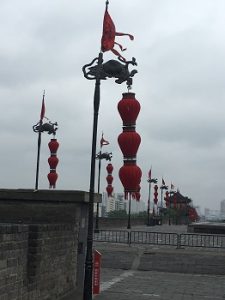
Turtle Lanterns on Xi’an Wall
sculpture on a lantern provides immediate information concerning which portion of the wall one is on at that time. As soon as one turns a corner and moves on to the next portion of the wall, the animal sculpture changes. One possibility is that these animals were a means of simple communication for the defenders of the city so that in the midst of a battle, with arrow fire or gunfire, smoke, darkness, and chaos, one could quickly know where one is on the wall and move efficiently to other areas as needed for the overall defense. The symbols may have been there for simple communication as much as for good luck. For the modern innovator, this reminds us that it is not always necessary to over-engineer a solution when a simple option would suffice. Rather than trying to come up with a different type of stone for parts of the wall, different patterns of crenellation of the towers, or other mechanisms, it could be that the Chinese simply decided to use symbols every few feet to provide basic location information to soldiers on the wall.
The Tomb of Emperor Qin Shi Huang and the Terracotta Warriors
In spite of its multitude of interesting sights (the Wild Goose Pagoda, the city walls and fortifications, Muslim Street, the Bell and Drum Towers), the city of Xi’an will probably always be best known for the tombs containing the terracotta warriors. Indeed, the name Xi’an is basically synonymous with the warriors, and hordes of tourists descend upon the city throughout the year to see these amazing clay
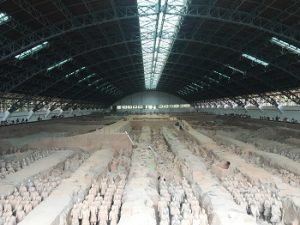
Terracotta Warriors
warriors. The terracotta warriors are a series of thousands of life-size and life-like sculptures that were buried in a series of pits near a mausoleum for the Emperor Qin in the year 246 BC. In essence, the Emperor wanted to make sure that he enjoyed as successful an afterlife as he did in the current world, so he enlisted an army of 700,000 laborers to build a giant mausoleum for himself as well as an entire army of clay figures, set up in marching formation, along with wagons, chariots, and horses, arrayed just as an army of real humans would be arrayed.
All these clay figures were buried with the king when he died in 210 BC. Scholars estimate that the various burial pits contain over 8,000 soldiers, 130 chariots, 520 horses, and 150 cavalry horses. What is perhaps most interesting is how life-like the figures were, as they were not merely replicas of one single person over and over. Rather, each clay figure appeared to be a different person, with slightly different facial features. While I enjoyed seeing this world-famous archaeological site, I did not expect to find so many parallels to modern innovation in the terracotta warriors, yet it seemed that innovation was lurking everywhere I turned.
Accidental Discovery
After the burial of the Emperor in 210 BC, the site was covered with earth and although some speculate that parts of it may have been looted, its location was untouched for centuries. The story of how the burial pits were discovered is a famous one in China, and the people involved in the discovery are seen as national heroes. In 1974, a group of farmers in Shaanxi Province were drilling a new well to find a water source. While drilling they came across a strange clay sculpture that looked human. Concerned, they contacted local authorities who notified
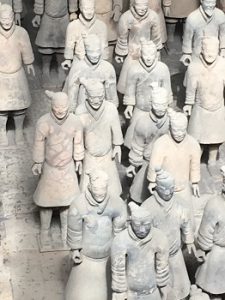
Terracotta Warriors – Detailed View
archaeologists and one of the greatest discoveries in world history was underway. Now that we know the layout of the site and the various burial pits, we know that had the farmers drilled their well a few meters towards the east, they would have missed the pit completely, would probably have found water, and would have gone on their merry way, with the site remaining undiscovered. Likewise, had their other water source not run dry, they would not have been in the fields in 1974 digging a new well.
Innovation Thoughts – Many authors have written about the importance of accidental discovery in innovation, and it seems as though everywhere one turns one continues to see examples of this phenomenon. For an innovator stuck staring at a blank sheet of paper trying to find a new idea, this could be discouraging, as one might think that if most innovation is through sheer luck, then the amount of effort one applies to innovation may not have much to do with whether one achieves a positive outcome. Rather than fretting about the lack of accidental discovery, I would propose that the frequency with which inadvertent innovation occurs should remind us of its importance and ensure that we are attuned to the possibility that it might happen at any point in time while we are working (or doing other things unrelated to work that might still lead to a new discovery). The proverbial notepad at one’s bedside so one can capture great thoughts one might have at nighttime is important, as is an awareness that when one comes up with a new idea or angle of attack on a problem, one should capture that information for future use. Indeed, one of the reasons the Chinese farmers in this story are national heroes is because they didn’t just continue drilling their well but stopped and sought assistance after what they found. It is said that luck favors those who are well-prepared, and innovators should be at the forefront of this concept.
Waiting for the Right Technology
Although the terracotta warrior museum complex is enormous, consisting of three huge structures built to cover and protect several of the burial pits that have been unearthed, there is still a huge amount of land around the Emperor’s burial complex that has not been excavated yet. At first one wonders why, because there would certainly be amazing archaeological finds in these new excavations. Yet the Chinese archaeologists have very sound reasons for leaving these areas undisturbed, at least for now. Although the clay warriors all look to be uniform in color (basically the
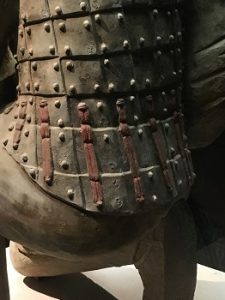
Archer Sculpture Showing Preserved Color on Armor
color of the original baked clay), archaeologists have found evidence that the warriors were originally painted in bright colors, clothed with silk garments, and adorned with wooden arms. Although the silk and wood did not survive centuries underground, many of the painted colors on the clay surfaces were preserved under the soil. Unfortunately, when these pieces were exposed to air for the first time in centuries, the paint deteriorated almost immediately, leaving the warriors as the generic earthy, clay color they appear to be today. Archaeologists have thus decided to leave some of the burial pits covered with dirt while they develop better excavation technologies that would allow them to preserve this paint. Some recent progress has been made on this front to prevent oxidation and preserve paint on a limited basis, though not enough to allow for large-scale excavations. This approach contrasts with the Egyptian excavations of tombs of the Pharaohs, which where exploited as soon as they were discovered in the early 1900s.
Innovation Thoughts – As innovators our mission is to find technology solutions to solve problems and the more daunting and challenging the problem, the greater reward we can expect to reap when we apply technology to solve a problem. Yet there are sometimes cases where an innovator may have a general idea of how to solve a problem but the proper technology may not exist yet to do so. The innovator may invest a great deal of time and money in trying to develop that new technology,
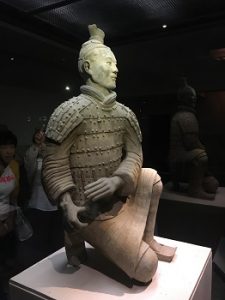
Terracotta Archer
but sometimes we find that the solution is too complex for one team to solve in a short period of time. The solution may require a strategy of waiting for technological progress to occur outside of the scope of the innovation team’s work before one can attack the problem again. Instead of implementing a partial solution that may not work at all, or spending a great deal of time and money to build something from scratch that may not work, sometimes it is best for the innovator to simply wait. The willingness of the Chinese archaeologists in Xi’an to hold off on further excavations in certain areas provides an excellent example of this concept. Rather than causing damage and impacting future discoveries, they are willing to wait until they have the right technology to solve their preservation problems.
Data to Support Hypotheses
As a student of history, one of the more fascinating aspects of the terracotta warriors was how much previously unknown information archaeologists have gleaned from this enormous site. For lack of a better term, the site is basically a giant time capsule that significantly enhances our understanding of aspects of life in the Qin Dynasty in the 2nd century BC, over 2,200 years ago. The best way to think about this is to imagine if one were a scholar of Chinese military history and the year was 1974, just before this discovery. One might have gathered information from written records or artwork and hypothesized about how Qin Dynasty armies were structured and how they went to battle. One might also have done research into whether their cavalry used stirrups on their horses, or what kinds of bows and arrows were used in battle.
In one fell swoop, with the discovery and excavation of this site, one obtained very precise answers to all of these questions. The way the terracotta warriors were arranged in perfect marching order in the burial pits most likely shows exactly how
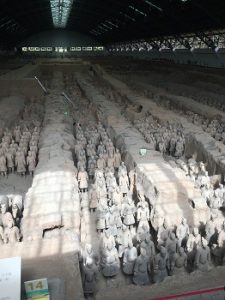
Terracotta Warriors in Formation
they would have operated in the year 200 BC, as it is unlikely that the Emperor would have wanted his afterlife army to be less well-prepared for combat than his earthly army. One could also see that the cavalry horses had no stirrups (they would not arrive until many years later). One could see how many horses were used to pull chariots, as well as the intricate details on archers, including the fact that an archer’s hair bun would be tied to the left of his head so he could reach into his arrow quiver with his right hand without interference. The number of troops in formation could also be gleaned easily, as well as the number of generals in command of each division. The amount of information arriving as a result of this archaeological find could be likened to a tidal wave of knowledge.
Innovation Thoughts – For the modern innovator, this case serves as a good example of the specificity that one needs to adhere to when identifying the type of evidence that one must collect to support a hypothesis. All the speculation in the world about Qin Dynasty military formations, however well thought-out and supported by volumes of writing and research prior to 1974, was rendered less relevant by the discovery of these burial pits. As an innovator, one’s goal in testing out whether a new innovation is successful should be to find evidence as powerful as what we see in the terracotta warrior burial pits. While that may not always be possible, the key is to find evidence that leaves few openings for others to challenge one’s conclusions. A key aspect of this strategy lies in the formation of strong, straightforward hypotheses that lend themselves well to supporting evidence.
Rivers of Mercury
As one approaches the area where the terracotta warrior tombs are located, one sees an enormous grass-covered mound in the near distance. The mound is clearly man-made and is situated in a prime location in terms of proximity to the nearby mountains, a river, and the plains around Xi-an, which suggests excellent Feng Shui characteristics. This mound is the main tomb of the Emperor Qin (the terracotta warrior pits radiate out from this tomb), and ancient writings suggest that the tomb
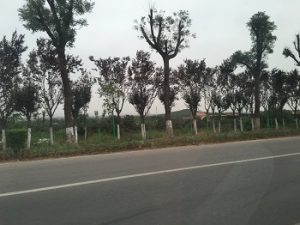
Emperor Qin Tomb – Earthen Mound in Distance
contains a magnificent palace complex surrounding the mausoleum containing the body of the Emperor. Supposedly the ceiling of the burial complex mimics the night sky with pearls as stars and constellations. Yet the tomb has never been excavated for several reasons. First, the Chinese see the site as sacred and do not wish to disturb it. Second, the site supposedly is protected by ancient booby traps, such as poisoned arrows or other devices that could harm anyone trying to reach the tomb. Third, as was the case with the terracotta warriors nearby, the Chinese archaeologists want to ensure they have the right excavation technology in place before doing any work at the site. Finally, the site supposedly contains rivers of liquid mercury, which the Emperor saw as a substance that was the key to eternal life. Indeed, it is thought that one of the reasons the Emperor died at the age of 39 was because of his habit of taking mercury pills for longevity. Interestingly, soil samples taken from the site today show unusually high levels of toxic mercury in the soil, suggesting that there may be truth to the speculation about what lies beneath the ground.
Innovation Thoughts – The example of Emperor Qin’s fascination with mercury led me to think about cases in which an innovator becomes too deeply involved in a single initiative. However promising that program might be, there comes a point where one has to decide whether to continue investing resources in an effort or moving on to a different approach. For the Emperor, the idea that eternal life sprang from consuming and surrounding oneself with mercury was just such an idea. Although looking back on the Emperor’s decision-making through the lens of modern science is not necessarily a fair way to assess events that occurred over 2,000 years ago, the example is still worthy of consideration for innovators. If one is spending a great deal of time on a project and unable to achieve a critical breakthrough, one could ask oneself if this project has become a “river of mercury†that is doing more harm than good to the innovator. This demonstrates the value of forcing regular, peer-reviewed checkpoints into any program to ensure that one does not become caught up in the moment and fails to see that something that is supposed to be beneficial is actually hurting the organization.
Knowledge Preservation
In between downtown Xi’an and the Xi’an International Airport, one can see another large earthen mound that looks quite similar to the one near the terracotta warriors site. This second mound is the tomb of the Emperor Jing of the Han dynasty, who followed Emperor Qin and sought to replicate what his predecessor had done. As
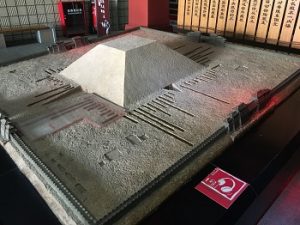
Model of Emperor Jing’s Tomb
was the case with the terracotta warriors, this complex was discovered inadvertently, though in this instance the people who found the site were road crews excavating land to build a road from downtown to the airport around the year 1998.  What they found was remarkably similar to the terracotta warriors site, with large, long pits containing thousands of clay soldiers and horses arrayed in marching formations, as well as livestock and other figures of the Emperor’s retinue.
Besides the welcome relief of a lack of crowds at this second site, there is another key difference between this site and the Qin Dynasty site. At the Emperor Jing site, the clay soldiers are not life-size. Rather, they are only a couple of feet tall (as opposed to the five- to six-foot-tall terracotta warriors) and look more like toys than real soldiers. They also did not have the intricate details of the Qin Dynasty soldiers. Historians speculate that there were two reasons that Emperor Jing surrounded himself with what amounts to a toy army rather than a real one. First, the Emperor was focused on a peaceful reign and eschewed warfare, high taxation, and forced labor, which meant that he could not engage the services of 700,000 workers to build his tomb as could his predecessor. Second, Emperor Jing suffered from the fact that the knowledge required to create the terracotta warriors in the Qin Dynasty may

Smaller Warriors at Emperor Jing’s Tomb
have died when Emperor Qin had the skilled artisans put to death upon completion of his tomb complex. It is also possible that the knowledge faded away as that skillset was not needed once the Qin tomb was completed.
Innovation Thoughts – The case of the loss of knowledge of how to create intricately detailed and life-size terracotta warriors reminded me of the Year2000 (Y2K) scenario faced by IT professionals in the late 1990s. In the early days of computer technology, memory and storage were at a premium so developers tried to write code in as simple a manner as possible. In the Y2K problem, coders in legacy languages such as COBOL or FORTRAN decided to indicate the year in their code using only two digits, such as “85†instead of “1985.â€Â The concern with Y2K was what would happen to these older systems when the year turned to 2000, which the computer would read as 00. Would computer calculations that were date-dependent malfunction because the system would assume that the year was 1900? Since these older systems ran critical infrastructure across the world, such as ATMs, power systems, air traffic control, and other necessities of modern life, a panic ensued in which companies sought out developers with knowledge of these older coding languages who could review the code line by line and implement patches to prevent disastrous outcomes.
In this situation, the companies with legacy systems who had an advantage over their competitors were the ones who had kept their legacy staff members and upskilled them with new technologies rather than laying them off and bringing in new resources. The legacy-skilled professionals could quickly and efficiently go through the old code (particularly if they had written the code) and identify needed fixes at internal cost rates, as opposed to expensive contractors who would come in at higher rates and charge these rates for many hours to get up to speed on the systems they
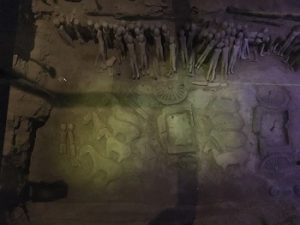
Smaller Warriors and Horses at Emperor Jing’s Tomb
had to fix. As innovators, we engage individuals with a wide variety of skillsets in our initiatives and because we work on so many different projects, we have a tendency to see these individuals as useful only for specific tasks and disposable once those tasks are done. Perhaps the lesson of Emperor Jing’s tomb of toy soldiers is that it is important to maintain knowledge of all forms because one never knows when that knowledge will be useful in the future. It may be better to upskill someone with knowledge of a legacy system than to bring in a new person each time we make a technological leap to a new platform.
The Stamp Seal
One of the more remarkable aspects of the burial pits of Emperor Jing is how much information archaeologists were able to collect in a short period of time, as the site went from discovery to museum in just a few years (1998 to 2006). As it turns out, archaeologists were able to identify exactly what was in each burial pit and link this to written information from the period because of several very tiny objects that they
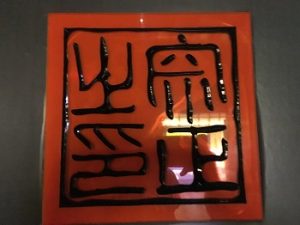
Stamp Seal
found buried in the pits. The objects were small, bronze stamp seals that were used to mark official correspondence by different officials in the Jing government. Because they were made out of metal, they survived underground for hundreds of years without deteriorating and could thus be analyzed in detail. Archaeologists could identify the specific pattern created by the stamp and link it to documents that survived from the era that were located elsewhere, thus providing specific information about what official’s retinue was inside each of the burial pits. For example, in the pit marked 15E, archaeologists found two stamp seals that belonged to an official named Dao Guan who managed the barns and livestock for the Emperor. In pit 21E, archaeologists found a stamp seal for Dong Zhi Ling Yin, a junior official in charge of dying and weaving fabrics for the Emperor. As a result of these pieces of information, archaeologists could better understand everything they found in the individual pits.
Innovation Thoughts – One of the challenges we face as innovators is how to sift through enormous amounts of information to make decisions concerning how to proceed on a given initiative. The data may come from different sources and point in different directions, but as innovators we must develop an approach to manage this deluge of information. In such a crush of findings, we may throw out ones that are tiny or seem insignificant. Usually, we try to synthesize the data to develop conclusions about what we are observing, but the example of the stamp seal in

Stamp Seal
Emperor Jing’s burial pits reminds us that sometimes key insights can come from a single and imperceptibly small piece of information. Synthesis is important, but one should be careful not to aggregate all of the individual bits of information into larger conclusions because sometimes great insight can come from individual data points that we may have overlooked. The minute attention to details exhibited by archaeologists (we often think of them measuring very precisely in their dig sites and pushing away dirt with very small brushes) is a good reminder of the need for innovators to be aware of the importance of every piece of information we capture.
The Food Museum at Jingjian Square
After a full day wandering around archaeological sites outside Xi’an, one eventually succumbs to the need to find nourishment for the evening. The most interesting place to eat in Xi’an is known as the Food Museum at Jingjian Square. The Food Museum is an outdoor food court consisting of dozens of traditional restaurants of varying sizes offering food from different ethnic groups and villages around the Shaanxi Region, ranging from Chinese Hamburgers (pork barbeque on a bun) to

Entrance to Food Museum
spicy roasted mini-potatoes to sweet sesame cakes. As is the case with any food purveyor in a city, one can sometimes judge the value of the food served by the length of the line of people waiting to get into the restaurant. Yet this was not the case with the longest line in the Food Museum. The longest line, consisting of 20-30 people, waited in front of a restaurant that did not serve any food. The people stood in line at the Liquan Rice Wine Wheat store to pay a few Yuan to obtain two small clay mugs which were subsequently filled with rice wine. The customers would then walk over to a brick wall by the store, drink the rice wine, say something in Chinese, then smash the clay mug on the ground, watching it shatter into pieces. The result was an enormous and growing pile of clay shards, which presumably would be swept up at some point in the future. According to legend, this act of drinking rice wine and shattering the mug gives the customer good fortune, so the line at this “restaurant†is always long.
Innovation Thoughts – Sometimes as innovators we stumble across an idea that seems promising but, upon more detailed investigation, we grow concerned that there is no market for that idea. It may be a new product that we think that would appeal to very few people, or a process improvement that only works on a subset of the overall processes we are investigating. The lesson of the Liquan Rice Wine

Liquan Rice Wine Wheat Restaurant
Wheat store in the Food Museum is that as innovators we should always assume that there is a market if only we can find the right niche for our products. One can imagine oneself as the person who first came up with the idea of getting people to pay to drink rice wine and shatter a mug. That person was likely laughed out of the room, but over time that idea became a real working concept. As innovators we are the people who may be laughed out of the room at first, but it is our job to figure out how to keep working on our idea until it has legs to stand on its own.
A good recent example of this comes from the Nobel Laureate in Economics Richard Thaler from the University of Chicago, interviewed recently by Steven Dubner for the Freakonomics Radio podcast. His field of study, behavioral economics, diverges from traditional economics in that it argues that humans are not always rational creatures whose actions can be predicted through complex mathematical optimization models. In other words, people often say they are going to do one thing (an act that might be in their best interest), but often end up doing something else. Thaler defines his field as the study of “supposedly irrelevant factors that, when it comes to how people actually live their lives, are in fact not irrelevant.† Thaler wryly
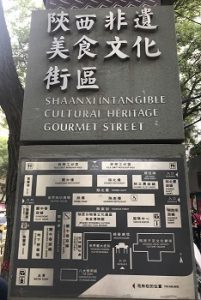
Formal Name of the Food Museum
observes that his mother was surprised that he was able to earn a living from such a mundane insight, much less a Nobel prize. At his toast to the Nobel Committee upon receiving his prize, Thaler said that “my fellow winners had discovered things like gravitational waves, and circadian rhythms. And I discovered the existence of humans in the economy.â€
Thaler’s statements and research align with the Liquan Rice Wine Wheat example in two ways. First, the economically irrational act of spending money for a sip of rice wine and destruction of a ceramic mug cannot be explained by traditional economics, thus the need for Thaler’s brand of behavioral economics. Secondly, as Thaler’s mother would observe, one can create a market for anything, including seemingly common-sense assessments that people do not always act in their self-interest. Thaler notes that his intellectual migration towards behavioral economics from the more quantitative approaches favored by most economists was due to his relatively weak skills in the areas of mathematics and econometrics. He thus found a way to create a new market for his services rather than trying to adapt his services to an existing market.
The Banpo Ancestral Village
The lands around Xi’an have evidence of some of the oldest civilizations in China and, indeed, the world. This is best exemplified in the Banpo Ancestral Village Museum, which contains archaeological sites showing how the Banpo people lived in the region in the years 4,500 to 3,750 BC. As was the case with other sites in China, this location was discovered by workers in 1953 who were digging in the area to build
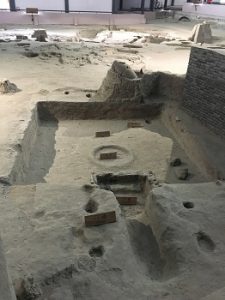
Banpo Semi-Subterranean House
a factory. The site covers 20 acres and contains thousands of stone tools, hundreds of tombs, over 100 house foundations, and is one of the most important Neolithic sites in the world.
Three features of this site prove particularly interesting from an innovation standpoint. First, the type of dwelling used by the Banpo villagers, known as the semi-subterranean house, shows an interesting middle ground in terms of design. Archaeological evidence suggests that before they moved into the Banpo village, humans in the area lived in caves. However, as any spelunker knows, caves can be quite wet environments, which fosters the growth of mold and can harm the inhabitants. Houses built on top of the ground, on the other hand, solve this humidity problem but also hotter, more difficult to build, and less stable. The middle ground between these two designs is the Banpo semi-subterranean house, which has a foundation dug into the ground with walls built up on the sides. This design provides the cooling and sturdiness of a cave with the dryness of an above-ground home.
A second interesting aspect of the Banpo villagers was how they buried their dead.
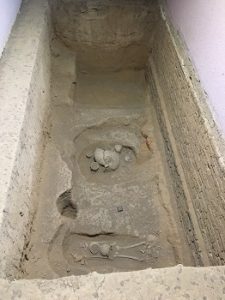
Banpo Burial Pit
In the tombs found at the site, the skeletons were all facing west. Since lifespans in the era were short (30-40 years) and living was likely quite a struggle, it is believed that the Banpo villagers wanted to follow the setting sun in the afterlife. They assumed that things would be better wherever the sun was going, since it would provide heat and light to them. Rather than facing the other direction to look for the rising sun (which could be seen as a sign of life returning), the Banpo wanted to follow the sun.
A final element of interest in the Banpo village was the large number of similarities between items found at this site and items we see elsewhere in the world. Even though different human societies were thousands of miles apart and it is highly unlikely that they would have ever come into contact with each other, we see similar items in archaeological sites around the world, such as amphorae for storing
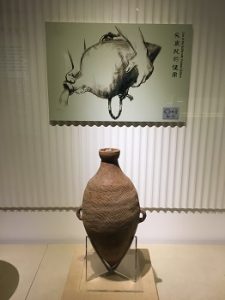
Banpo Amphora
liquids, bone hooks for fishing, ceramic bowls and pots, and bone flutes with which to play music. It is fascinating to ponder how humans in these vastly different places ended up with very similar designs to solve the problems of their daily lives.
Innovation Thoughts – These three observations from the Banpo village offer modern innovators with three possible strategies for coming up with new approaches to solve problems. The semi-subterranean house is a great example of striking the middle ground when faced with two competing approaches to a new idea. Rather than trying to decide upfront which approach is better and investing time and resources into making an approach work in spite of its flaws, a better strategy may be to split the difference between two competing ideas and investigate the hybrid approach as a possible solution. In the course of performing this task, one might even obtain insights that point to one of the original pathways as the best strategy. Yet it is more likely that one will develop a synthesized solution that combines the best elements of both alternatives.
The practice of burial to follow the sun suggests that an innovator should consider adopting a strategy of going after what one knows best rather than spending time waiting on the possibility of something that might happen. In other words, an innovator should focus his or her energy on pursuing options that are variants of things that one already knows will work rather than betting that an event will occur in the future that might prove beneficial. A good example of this comes from the music streaming service Spotify and how it has transformed the marketplace for musicians. In the past, a musician would build a touring schedule and hope that residents of those cities would attend the concert. Now with Spotify’s streaming database, a musician can pinpoint precisely where customers are listening to his or her music in the greatest density and schedule concert events using that data. The musician can follow the audience rather than setting up an event and hoping the audience finds the musician.
Finally, in terms of the similarities of tools and other characteristics of human civilization across the world, an innovator trying to find a solution to a problem should recognize that there are common human wants and needs that break the barriers of civilization, and this common human experience is key to understanding how to design things that can improve the quality of life for humans around the world. When faced with a challenge of building something new and useful, and innovator may want to spend time thinking about how people in general would use the new solution rather than focusing too intensively on a particular type of person. In examining the basic human elements of a new initiative, one might stumble across an approach that makes the idea even more valuable.
Sources:
Photographs courtesy of the author
https://www.wsj.com/articles/mr-xis-superpower-plans-1532013258
https://www.wsj.com/articles/trade-war-punctures-chinas-pride-in-its-technology-1530186663
https://www.wsj.com/articles/china-mines-silicon-valley-for-chinese-tech-talent-1530028118
https://www.wired.co.uk/article/china-social-credit
https://www.globalresearch.ca/china-rise-fall-and-re-emergence-as-a-global-power/29644
https://en.wikipedia.org/wiki/Xian
https://en.wikipedia.org/wiki/Bell_Tower_of_Xian
https://en.wikipedia.org/wiki/Lotrscak_Tower
https://en.wikipedia.org/wiki/Fortifications_of_Xian
https://en.wikipedia.org/wiki/Terracotta_Army
https://www.livescience.com/22454-ancient-chinese-tomb-terracotta-warriors.html
https://www.ancient.eu/Banpo_Village/
Wait! Before you go…
Choose how you want the latest innovation content delivered to you:
- Daily — RSS Feed — Email — Twitter — Facebook — Linkedin Today
- Weekly — Email Newsletter — Free Magazine — Linkedin Group
 Scott Bowden is founder and CEO of Bridgeton West, LLC, a firm consultancy focusing on historical innovation. Scott previously worked for IBM Global Services and the Independent Research and Information Services Corporation. Scott has a PhD in Government/International Relations from Georgetown University.
Scott Bowden is founder and CEO of Bridgeton West, LLC, a firm consultancy focusing on historical innovation. Scott previously worked for IBM Global Services and the Independent Research and Information Services Corporation. Scott has a PhD in Government/International Relations from Georgetown University.
NEVER MISS ANOTHER NEWSLETTER!
LATEST BLOGS
Four ways you can ensure employees take accountability for their work
One of the most important driving factors for any successful business is a high-performing team. Having people working for you…
Read MoreWhat is digital upskilling and why is it important?
Photo by Annie Spratt on Unsplash In a world of business that never stands…
Read More


